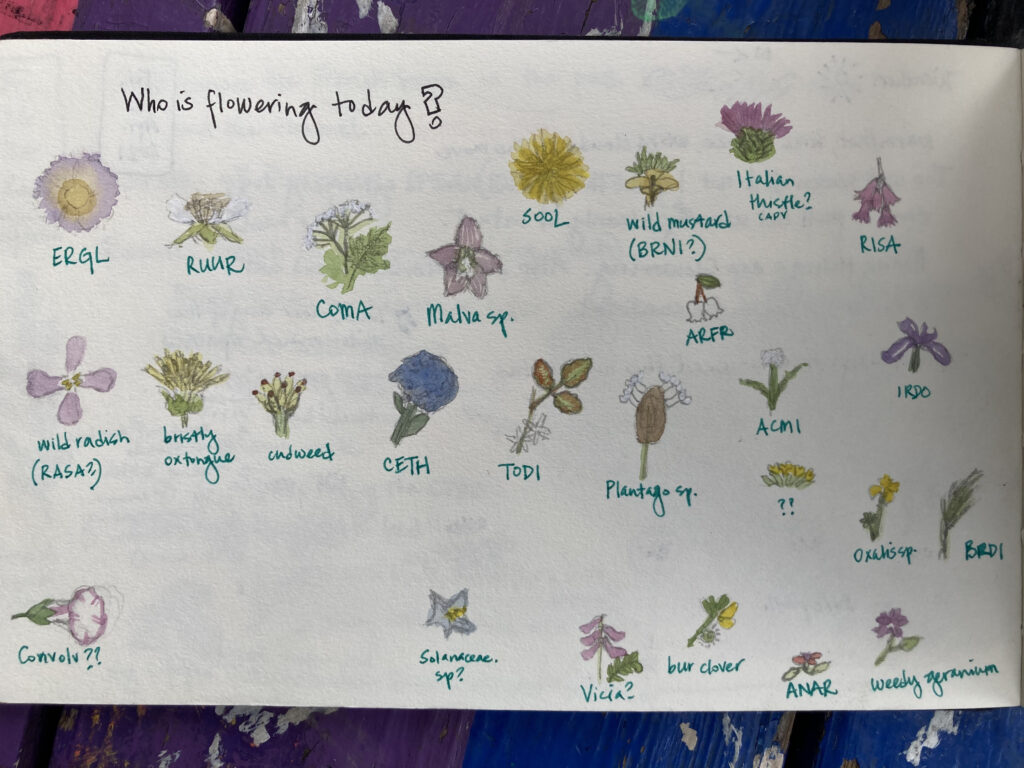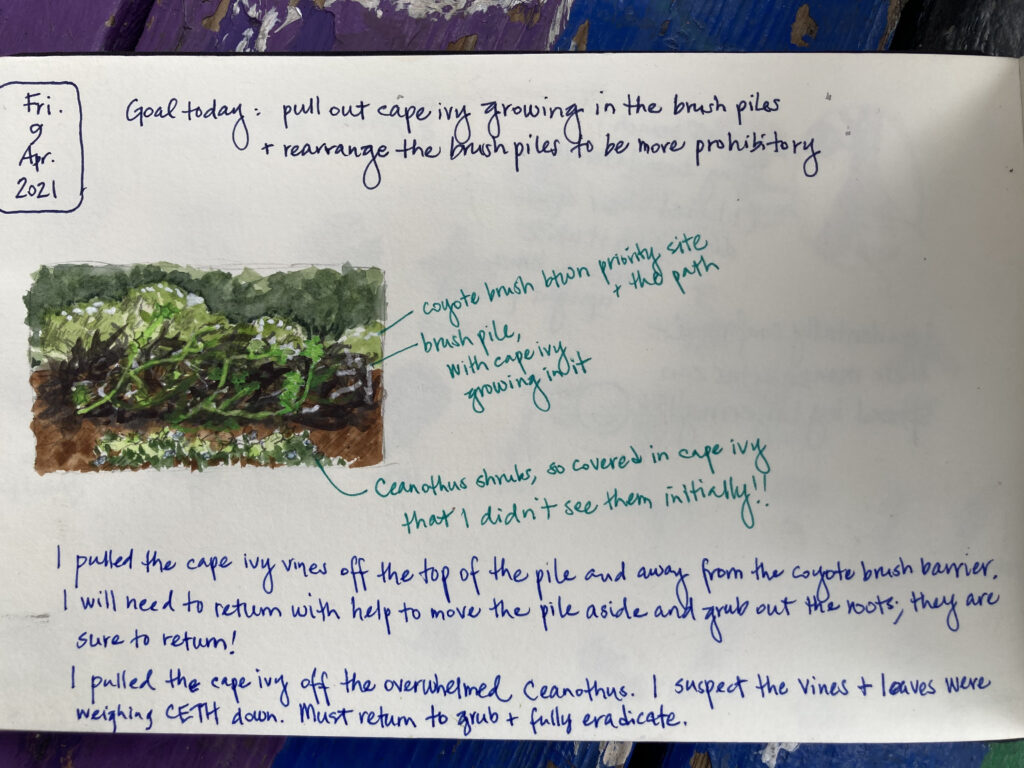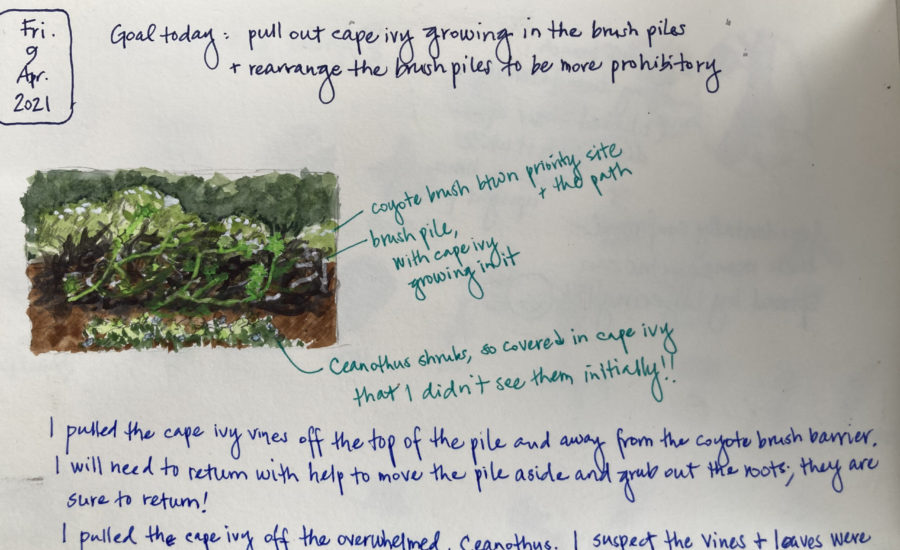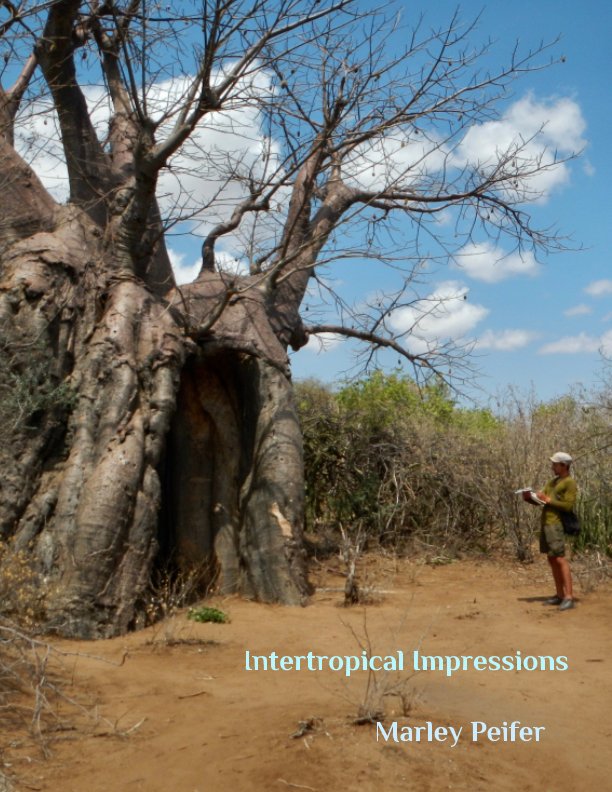Native plants restoration and other types of habitat and ecological restoration are essential work these days. Like humans, plants and other animals need homes to live in – homes that are being degraded worldwide at an alarming rate. In this conversation, Marley and I talk about how nature journaling can be combined with plant restoration practices and activities, using restoration sites in the Presidio of San Francisco as examples.
What is native plants restoration, and why do we do it?
Native plants restoration means: helping a wild habitat recover that human activities have previously degraded. Plants are often the ecosystem architects that create homes for animals and other life. Without these plants, creatures like birds, insects, mammals, reptiles and many others will not have homes and are not able to survive. This loss of habitat, or home, is the greatest cause of species dying out all over the world.
Native plants often support a very particular group of creatures and relationships, ones that cannot be found in other places. Introduced plants seldom have all of the complex interrelations a native plant has with those many creatures. So by restoring a damaged environment with native plants, humans are helping that ecosystem to: 1) find and maintain balance, 2) preserve the diversity of different species in that area, and 3) increase everyone’s collective health.
Native plants restoration work can involve many tasks, such as reshaping the area to be restored (sometimes with heavy machinery!), raising and planting native plants, weeding out introduced or invasive species, seed harvesting, pruning, ongoing monitoring, picking up trash, and education.

Why should we nature journal our native plants restoration work?
Now native plants restoration is well and good, but you might be wondering – why should we journal about it? Wouldn’t it be more efficient to put 100% of our focus into getting the work done, instead of sitting around writing about it? While the restoration work is the priority when we are in the field, writing down our work can be an important part of the process.
Here are 6 reasons we should nature journal our native plants restoration work:
- We are changing that particular ecosystem with our work. In the same way that as nature journalers we like to observe nature’s changes, it’s important to document the effects we have on the environment.
- By documenting what we are doing, we make it possible for others to follow in our footsteps. If someone else wants to do this type of work, or wants to join you, they can see from your field journal what to do.
- It opens up our thinking. If we write down questions that come up or observations or thoughts, we invest more in the habitat we are restoring.
- By writing down what we did, we can go back later and modify our process. We might discover a more efficient way of doing something, or notice a consideration we had not had before.
- The work we do is important, so it’s important to validate that.
- By writing it down, we regenerate our excitement. We fall in love even more with the habitat and our work, and it enables us to take a little of the magic of the field home with us.

How can you be prepared when you’re going out to do fieldwork?
Now, onto the logistics. How do you juggle doing the work and nature journaling about it when you’re in the field?
First of all, it’s important to prioritize your field work. That means you won’t get as much time to do nature journaling, so plan for a shorter session. That doesn’t mean you can’t set aside some times for a longer session or even continue entries once you’ve get home, but it does mean you have to be really sharp about what you do with your journal while you are in the field.
Second of all, pack light. You’re essentially carrying two different kits with you: your restoration toolkit and your nature journaling toolkit. You might have tools, such as a pick mattock or a shovel or a clipboard, in addition to protective layers, basic first aid materials, and sustenance. With your nature journaling kit, carry minimal supplies: your journal itself, a couple of writing utensils, and a very small selection of colors if you choose.
Third, try to come up with a standard reporting format. Choose the things you think are most important to record when you’re out in the field. I tend to choose the following three basics: metadata, what our goal or objective was, and what we got done/the result. By being consistent about what you record, you prevent yourself from getting overwhelmed, as well as build a better habit of using your journal in the field instead of entrusting everything to memory for when you get home. It also makes it easier to add more notes, such as wildlife observations, if you have already started your journal page.
To learn more tips, please watch my interview with Marley, as well as my workshop on tips and techniques for nature journaling our field work. Hope to see you out there!

You can learn more from Yvea on her channel: https://www.youtube.com/user/MovingFlash415
And on her instagram: www.instagram.com/yveaeaton
Want to learn more about the intersection between nature journaling and restoring our connection to the land through stories? Check out this upcoming class with Rebecca Rolnick: https://johnmuirlaws.com/event/nature-journaling-for-ecological-re-story-ation/2021-09-27/
More info about rare and endangered plants in the Presidio: https://www.nps.gov/prsf/learn/nature/rare-and-endangered-plants.htm
You can learn more about California native plants in general at: https://www.cnps.org/
Just getting started with nature journaling?
Need more tips? If so, check out this post. It will walk you through how to nature journal in 10 steps.
Need help choosing nature journaling supplies? Check out Nature Journaling Supplies: What You Need and What You Do Not

